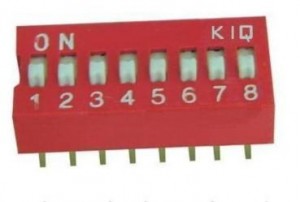DIP SWITCH
The all new features of iWatch Access Control Panel are:
- Fully networkable.
- Uses a distributed processing system.
- Scans the readers,
- Supports remote sites through modems.
- Can be used offline.
The best feature of iWatch Access Control Panel is the TCP/IP support. It means that it can be managed remotely from any corner of world. The TCP/IP connectivity depends on the IP (Internet Protocol). The Internet Protocol (IP) is a protocol used for communicating data across a packet-switched internetwork using the Internet Protocol Suite. The Internet Protocol defines addressing methods and structures for datagram encapsulation.
Because of the abstraction provided by encapsulation, IP can be used over a heterogeneous network, i.e., a network connecting computers may consist of a combination of Ethernet, ATM, FDDI, Wi-Fi, token ring, or others. Each link layer implementation may have its own method of addressing (or possibly the complete lack of it), with a corresponding need to resolve IP addresses to data link addresses. This address resolution is handled by the Address Resolution Protocol (ARP) for IPv4 and Neighbor Discovery Protocol (NDP) for IPv6.
The default IP of iWatch Access Control Panel is xxx.xxx.xxx.112.
The IP is stored in the network Card present on the Panel. Later on, for our convenience and according to our site setup we can change the predefined IP with the help of specific tools.
There is a small switch present on the iWatch Access Control panel, which is known as DIP SWITCH. With the help of DIP switch we can reset the IP to xxx.xxx.xxx.112 from any later defined IP.
Prerequisite: The IP of server should be xxx.xxx.xxx.52.
A DIP (dual in-line package) switch is a set of manual electric switches that are packaged in a group. This type of switch is designed to be used on a printed circuit board along with other electronic components and is commonly used to customize the behavior of an electronic device for specific situations.
DIP switches are an alternative to jumper blocks. Their main advantages are that they are quicker to change and there are no parts to lose.
There are many different kinds of DIP switches. Some of the most common are the rotary, slide, and rocker types. The DIP switch package also has socket pins or mounting leads to provide an electrical path from the switch contacts to the circuit board. Although circuits can use the electrical contacts directly, it is more common to convert them into high and low signals. In this case the circuit board also needs interface circuitry for the DIP switch, consisting of a series of pull-up or pull-down resistors, a buffer, decode logic, and other components. Typically the device’s firmware reads the DIP switches when the device is powered on.
DIP Switch can be used in conditions like:
1) Loss of communication.
2) Not getting ping response.
3) Loss of connectivity in between Server and Panel.
4) Abnormal blinking of LEDs.
5) Assigning new IP to Panel.









August 19th, 2010 at
Make an impression on, thanks a bunch m8
August 19th, 2010 at
Would it be acceptable to syndicate your feed?
August 20th, 2010 at
Great article! I like your blog site, is it ok to make use of it for resyndication?
August 21st, 2010 at
shares use a good web site decent Thank you for your personal exertion to aid me;)
August 21st, 2010 at
found your site on del.icio.us today and really liked it.. i bookmarked it and will be back to check it out some more later
August 23rd, 2010 at
Thanks for your appreciation, keep posting comments on blog..
August 23rd, 2010 at
Thanks. Yeah, you can use the knowledge anywhere, afterall knowledge increases on spreading. right??
Keep posting comments and keep visiting blog. Thanks again..
August 23rd, 2010 at
we will love to know how exactly you want to syndicate the feeds??
August 23rd, 2010 at
Thanks a lot for appreciation, Buddy.
September 10th, 2010 at
Hi, admin, can I copy some information from the post?
September 10th, 2010 at
Yeah, sure. you can.. Thanks for showing interest.
September 24th, 2010 at
Well, really happy to read this article, I have bookmarked your website and will turn back to read your new articles.